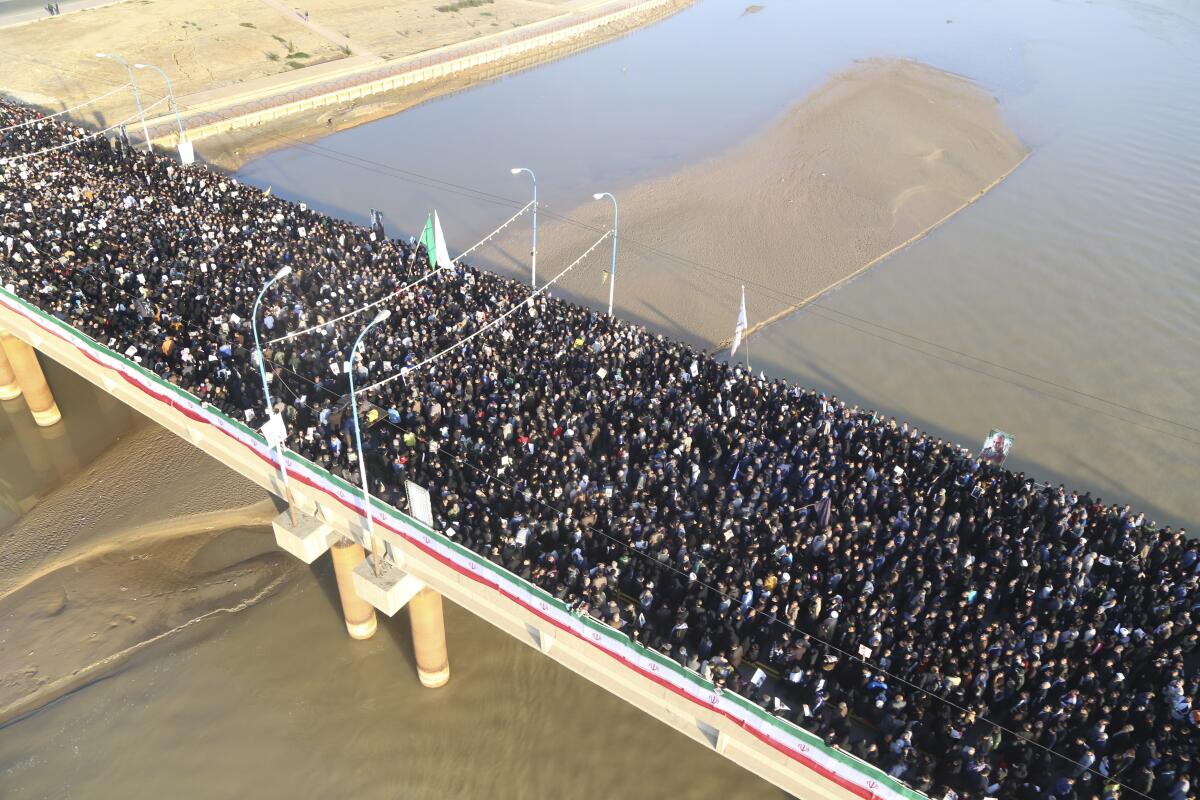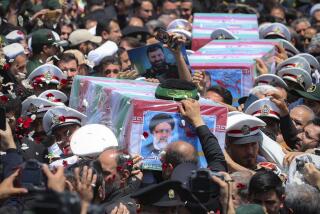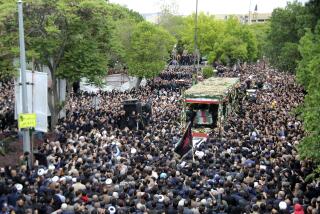Suleimani’s body arrives in Iran as Trump issues new threats

- Share via
TEHRAN — The body of Gen. Qassem Suleimani arrived Sunday in Iran, where thousands of mourners thronged his coffin ahead of a grand funeral procession across the Islamic Republic amid soaring tensions between Iran and the U.S.
President Trump has threatened to bomb 52 sites in Iran if it retaliates by attacking Americans.
The U.S. drone strike killing Suleimani in Iraq on Friday escalated the crisis between Tehran and Washington after months of trading attacks and threats that put the wider Middle East on edge. The conflict is rooted in Trump pulling out of Iran’s nuclear deal with world powers. The accord is likely to further unravel as Tehran is expected to announce as early as Sunday it will break another set of its limits.
Iran has promised “harsh revenge” for the U.S. attack. Iranians across all political lines were shocked by the death of a commander widely seen as a pillar of the Islamic Republic, at a moment when it is beset by U.S. sanctions and recent anti-government protests. Retaliation could come through the proxy forces Suleimani oversaw as the head of an elite unit within the paramilitary Revolutionary Guard. Suleimani’s longtime deputy, Esmail Ghaani, already has taken over as the Quds Force’s commander.
Late Saturday, a series of rockets launched in Baghdad fell inside or near the Green Zone, which houses government offices and foreign embassies, including the U.S. Embassy.
Trump wrote on Twitter afterward that the U.S. had already “targeted 52 Iranian sites (representing the 52 American hostages taken by Iran many years ago), some at a very high level & important to Iran & the Iranian culture.”
Trump did not identify the targets but added that they would be “hit very fast and very hard.”
The 1954 Hague Convention, of which the U.S. is a party, bars any military from “direct hostilities against cultural property.” However, such sites can be targeted if they have been repurposed and turned into a legitimate “military objective,” according to the International Committee of the Red Cross.
Iran, home to 24 UNESCO World Heritage sites, has in the past reportedly guarded the sprawling tomb complex of the Islamic Republic’s founder, Ayatollah Ruhollah Khomeini, with surface-to-air missiles.
After thousands in Baghdad on Saturday mourned Suleimani and others killed in the strike, authorities flew the general’s body to the southwestern Iranian city of Ahvaz, according to the state-run IRNA news agency. An honor guard stood by early Sunday as mourners carried the flag-draped coffins of Suleimani and other Guard members off the tarmac.
The caskets then moved slowly through streets choked with mourners wearing black, beating their chests and carrying posters with Suleimani’s portrait. Demonstrators also carried red Shiite flags, which traditionally both symbolize the spilled blood of someone unjustly killed and call for their deaths to be avenged.
Ahvaz was a focus of fighting during the bloody, 1980-88 war between Iraq and Iran in which the general slowly grew to prominence. After that war, Suleimani joined the Guard’s newly formed Quds, or Jersualem, Force, an expeditionary force that works with Iranian proxy forces in countries such as Iraq, Lebanon and Yemen.
Authorities also plan to take Suleimani’s body to Mashhad later Sunday, as well as Tehran and Qom on Monday for public mourning processions, followed by his hometown of Kerman for burial Tuesday.
This marks the first time Iran honored a single man with a multicity ceremony. Not even Khomeini received such a processional with his death in 1989. Suleimani on Monday will lie in state at Tehran’s famed Musalla mosque as the revolutionary leader did before him.
Suleimani was the architect of Iran’s regional policy of mobilizing militias across Iraq, Syria and Lebanon, including in the war against the Islamic State group. He was also blamed for attacks on U.S. troops and American allies going back decades.
Though it’s unclear how or when Iran may respond, any retaliation was likely to come after three days of mourning declared in both Iran and Iraq. All eyes were on Iraq, where America and Iran have competed for influence since the 2003 U.S.-led invasion.
After the airstrike early Friday, the U.S.-led coalition has scaled back operations and boosted “security and defensive measures” at bases hosting coalition forces in Iraq, a coalition official said on condition of anonymity according to regulations.
Meanwhile, the U.S. has dispatched an additional 3,000 troops to neighboring Kuwait, the latest in a series of deployments in recent months as the standoff with Iran has worsened. Protesters held demonstrations in dozens of U.S. cities Saturday over Trump’s decisions to kill Suleimani and deploy more troops to the Mideast.
In a thinly veiled threat, one of the Iran-backed militias, Asaib Ahl Haq, or League of the Righteous, called on Iraqi security forces to stay at least a kilometer, or 0.6 mile, away from U.S. bases starting Sunday night. However, U.S. troops are invariably based in Iraqi military posts alongside local forces.
The Iranian parliament on Sunday opened with lawmakers in unison chanting: “Death to America!” Parliament speaker Ali Larijani compared Suleimani’s killing to the 1953 CIA-backed coup that cemented the shah’s power and to the U.S. Navy’s shootdown of an Iranian passenger plane in 1988 that killed 290 people. He also described American officials as following “the law of the jungle.”
“Mr. Trump! This is the voice of Iranian nation. Listen!” Larijani said as lawmakers chanted.
A spokesman for Iran’s armed forces, Gen. Abolfazl Shekarchi, likewise threatened the U.S. by saying Iran and the “resistance front will decide the time, place and way” revenge will be carried out.
Iraq’s government, which is closely allied with Iran, condemned the airstrike that killed Suleimani, calling it an attack on its national sovereignty. Parliament is meeting for an emergency session Sunday, and the government has come under mounting pressure to expel the 5,200 U.S. troops who are based in the country to help prevent a resurgence of the Islamic State group.
Also Saturday, NATO temporarily suspended all training activities in Iraq because of safety concerns, Canadian Defense Minister Harjit Sajjan said.
The U.S. has ordered all citizens to leave Iraq and temporarily closed its embassy in Baghdad, where Iran-backed militiamen and their supporters staged two days of violent protests in which they breached the compound. Britain and France have warned their citizens to avoid or strictly limit travel in Iraq. Oman, long an interlocutor between Iran and the West, urged Tehran and Washington on Sunday to pursue dialogue.
No one was hurt in the embassy protests, which came in response to U.S. airstrikes that killed 25 Iran-backed militiamen in Iraq and Syria. The U.S. blamed the militia for a rocket attack that killed a U.S. contractor in northern Iraq.
More to Read
Sign up for Essential California
The most important California stories and recommendations in your inbox every morning.
You may occasionally receive promotional content from the Los Angeles Times.










